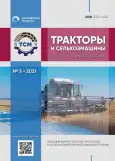Разработка машинной технологии для реабилитации земель
- Авторы: Натриашвили Т.М.1, Махароблидзе З.К.1, Маргвелашвили В.О.1, Шарашенидзе С.Г.1
-
Учреждения:
- Институт механики машин им. Р. Двали
- Выпуск: Том 88, № 5 (2021)
- Страницы: 13-17
- Раздел: Новые машины и оборудование
- URL: https://journals.rcsi.science/0321-4443/article/view/105661
- DOI: https://doi.org/10.31992/0321-4443-2021-5-13-17
- ID: 105661
Цитировать
Полный текст
Аннотация
В Грузии в настоящее время актуален вопрос реабилитации заброшенных сельскохозяйственных земель. На реабилитированных участках осуществляется посадка винограда, интенсивных садов и разных плантационных культур. Реабилитация включает в себя очистку земли от растений и корневой системы, глубокую обработку почвы, устройство гребня и подготовку почвы для посадки саженцев. Известно, что из сельскохозяйственных работ, культурно-технические работы характеризуются наиболее высокими энерго- и трудовыми затратами. Одной из энергоемких операций в технологии реабилитации земель является очистка почвы от корневой системы растений. Несмотря на технический прогресс до сих пор не решен ряд проблемных вопросов по проектированию и изготовлению машин для некоторых сельскохозяйственных работ. Дело в том, что при реабилитации почвы применяют машины, рабочие органы которых спроектированы без учета реологических показателей обрабатываемой среды. В результате этого технологические работы сопровождаются высокими энергозатратами и приводят к механической эрозии обрабатываемой среды. Часто встречаются дорогие, широкозахватные мульчеры европейского производства с молоткообразными рабочими органами, использование которых противоречат теории резания и измельчения почвы и дает особенно отрицательные результаты при обработке почвы с повышенной влажностью.
В работе представлены технология и система машин для реабилитации заброшенных сельскохозяйственных земель. Рассмотрены основные принципы проектирования существующих машин для реабилитации земель. Изложены предпосылки для проектирования рабочих органов роторных сельскохозяйственных машин, работающих в упруго-пластической среде. Отмечено, что основой создания почвообрабатывающих машин должны быть реологические и механические показатели обрабатываемой среды. С применением теории удара исследован процесс взаимодействия режущих ножей и корневой системы растения в почвенной среде. Получено аналитическое изображение для расчета силы удара.
Ключевые слова
Полный текст
Открыть статью на сайте журналаОб авторах
Т. М. Натриашвили
Институт механики машин им. Р. Двали
Автор, ответственный за переписку.
Email: rdimmg@yahoo.com
д.т.н.
Грузия, ТбилисиЗ. К. Махароблидзе
Институт механики машин им. Р. Двали
Email: rdimmg@yahoo.com
д.т.н.
Грузия, ТбилисиВ. О. Маргвелашвили
Институт механики машин им. Р. Двали
Email: rdimmg@yahoo.com
к.т.н.
Грузия, ТбилисиС. Г. Шарашенидзе
Институт механики машин им. Р. Двали
Email: rdimmg@yahoo.com
к.т.н.
Грузия, ТбилисиСписок литературы
- Мульчеры и измельчители пней. URL: https://lesprominform.ru/jarticles.html?id=1329#second-nav-recommend (дата обращения: 11.09.2021).
- Гольдсмит В. Удар. Теория и физические свойства ударяемых тел. М.: Издательство литературы по строительству. 1965. 447 с.
- Махароблидзе Р.М. Методы теории удара и реологии в земледельческой механике. Тбилиси: «Интеллект». 2006. 314 с.
- Синеоков Г.Н., Панов И.М. Теория и расчет почвообрабатывающих машин. М.: Машиностроение, 1977. 326 с.
- Кормшиков А.Д. Механизация обработки почвы на склонах. Чебоксары: Чувашское книжное издательство, 1981. 125 с.
Дополнительные файлы









